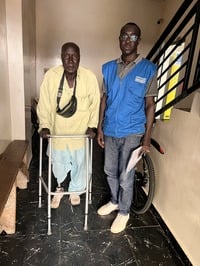In Senegal, stemming the tide of diabetes
In Saint Louis, Senegal, the diabetes rate is five times higher than in the rest of the country. HI is working here with associations and communities to inform and support patients.

Fatou Ndiaye, who has diabetes, being monitored by an HI member at her home in Saint-Louis. | © N. F. Boye / HI
Diabetes is a chronic disease that causes many deaths and can be very debilitating, leading to amputations and permanent disabilities. For years, and in many countries, HI has been working to prevent the spread of diabetes and to support those affected by it. Today, this work is underway in Saint-Louis, Senegal.
Preventing and controlling diabetes in Saint-Louis
In Saint-Louis, a city in the north of Senegal, it was estimated that, in 2015, more than 40,000 people had diabetes out of a total population of approximately 237,500. The progression of the disease is worrying in this region where a statistical study carried out by HI between 2019 and 2022 revealed a prevalence rate of over 15.95%, compared with 3.4% in the country's other regions. Diabetes is a disease that can lead to serious complications, such as vision loss, kidney failure, strokes and amputations. But it doesn't have to be this way: with the right treatment, a healthy diet and regular exercise, it's perfectly possible to be healthy while living diabetes.
In partnership with the Ministry of Health and Social Action, the Gaston Berger University of Saint-Louis and the Saint-Louis Diabetes Association of Senegal, this has been HI’s objective in the region since 2019. HI has been working to prevent and curb the rise in diabetes by informing people about the risk factors as well as the good practices to adopt, encouraging screening and supporting health professionals to provide better care.Thus, between 2019 and 2022, more than 12,500 people were informed about risk factors and the need for screening. In 2023, HI's actions ensured that 158 paramedical staff received training to improve diabetes care and 142 community workers were trained to pass on information to the public.
Helping diabetics live a healthy life
 Cheikh Tidiane Ngom, a 75-year-old father of 14, lives in Saint-Louis with his children. An electrician by trade, he was diagnosed with diabetes in 2019. Life went on as usual until one day in 2023 when Cheikh discovered a small sore on his right leg. It looked harmless enough, so he tried to treat it himself, but it wouldn’t heal. He then decided to go to the hospital for more appropriate care, but after a few weeks of treatment, the doctor gave him some terrible news.
Cheikh Tidiane Ngom, a 75-year-old father of 14, lives in Saint-Louis with his children. An electrician by trade, he was diagnosed with diabetes in 2019. Life went on as usual until one day in 2023 when Cheikh discovered a small sore on his right leg. It looked harmless enough, so he tried to treat it himself, but it wouldn’t heal. He then decided to go to the hospital for more appropriate care, but after a few weeks of treatment, the doctor gave him some terrible news.
“He explained that it was diabetic foot and that the only solution was to amputate my leg. I had no choice, but I was desperate, because how would I be able to continue working to support my family?”, he explained.
After his amputation, HI helped Cheikh to obtain a prosthesis fabricated at the Saint-Louis rehabilitation and orthopaedic centre (CRAO). Accompanied throughout his treatment, he received all the care he needed to get back on his feet.
”You can't imagine how pleased I was when I received this prosthesis. Now I can go to the health centre as I please and I often go out to visit my friends. I've resumed my activities and my situation has improved considerably. Thank God”, he says, happily.
Cheikh's experience has had a profound effect on him, and he is now committed to raising awareness among all those close to him, advising them to get tested and urging them to take steps to prevent diabetes and its complications.
The second phase of the “Together against diabetes in Saint-Louis” project will run from March 2023 to March 2026. Its aim is to contribute to the prevention and quality of care for diabetes and diabetes-related complications in the districts of Saint-Louis and Dagana.





